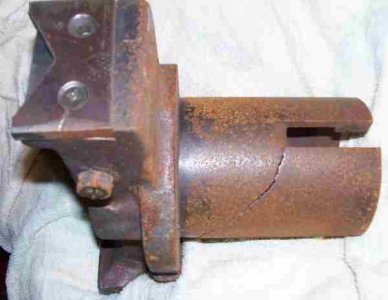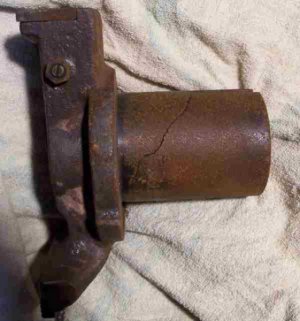- Joined
- Feb 18, 2016
- Messages
- 451
I didn't see a forum section on welding. But I know a lot of machinists also weld. I'm wondering if anyone can give me some hints on how to repair an old vice. I'm guessing this is cast iron?
Here are some photos of the vice and a nasty crack in the casting.
Top view: (actually I guess this is really the bottom of the vice jaw).
The crack starts at the lower left corner of the rectangular cut out on the round shaft. And continues all the way around to about the midpoint on the other side (see side view photo)

Side view:

I have no experience welding cast iron. But I do have experience welding steel to steel.
I have 3 methods to weld.
1. Oxy-Acetylene torches and lots of flux-coated brazing rod.
2. An old AC/DC stick welder
3. A brand new TIG welder.
I would like to TIG weld it if possible. But I'm not sure what I need to do that.
Are their special rods I'll need to get for welding cast iron?
Two more Question on pre-welding preparation:
1. I'm thinking I'll need to grind a V-groove all the way down the crack. But I thought I'd double check here whether that's actually needed? I didn't want to hack into this thing with a grinder until I get some feedback.
2. I've always heard that cast iron needs to be preheated before welding lest it might crack while welding it due to extreme temperature changes. If that's true what does it take to heat it up? Should I just heat it up with the oxy-acet torch for a while before welding it? And if so, how hot does it need to be.
Thanks for reading and for any suggestions or guidance you have to offer..
Here are some photos of the vice and a nasty crack in the casting.
Top view: (actually I guess this is really the bottom of the vice jaw).
The crack starts at the lower left corner of the rectangular cut out on the round shaft. And continues all the way around to about the midpoint on the other side (see side view photo)

Side view:

I have no experience welding cast iron. But I do have experience welding steel to steel.
I have 3 methods to weld.
1. Oxy-Acetylene torches and lots of flux-coated brazing rod.
2. An old AC/DC stick welder
3. A brand new TIG welder.
I would like to TIG weld it if possible. But I'm not sure what I need to do that.
Are their special rods I'll need to get for welding cast iron?
Two more Question on pre-welding preparation:
1. I'm thinking I'll need to grind a V-groove all the way down the crack. But I thought I'd double check here whether that's actually needed? I didn't want to hack into this thing with a grinder until I get some feedback.

2. I've always heard that cast iron needs to be preheated before welding lest it might crack while welding it due to extreme temperature changes. If that's true what does it take to heat it up? Should I just heat it up with the oxy-acet torch for a while before welding it? And if so, how hot does it need to be.
Thanks for reading and for any suggestions or guidance you have to offer..

